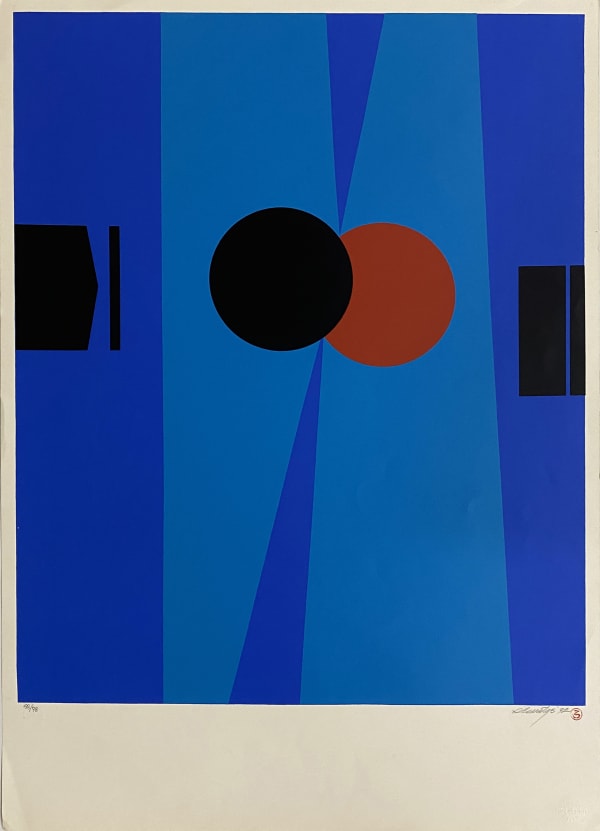Works
-
 Salvador CorratgeUntitled, 1992Serigraph27 1/2 x 19 1/2 in.
Salvador CorratgeUntitled, 1992Serigraph27 1/2 x 19 1/2 in.
69.8 x 49.5 cm.Ed.78 of 98View more details -
 Salvador CorratgeFlower , 1990Lithograph27.50 x 20 in
Salvador CorratgeFlower , 1990Lithograph27.50 x 20 in
69.85 x 50.8 cmEd.1 of 25View more details -
 Salvador CorratgeMuerte de la Carolina, 1984Ink on paper18 x 20 in
Salvador CorratgeMuerte de la Carolina, 1984Ink on paper18 x 20 in
45.72 x 50.8 cmView more details
Biography
Geometric abstraction was the focus of his abstract work; however, in 1953 he showed alongside the members of Los Once, a militant group of young artists who were more interested in Tachism and Abstract Expressionism.
The passing of Salvador Corratge on November 20, 2014 in Miami—while he was visiting, working and preparing what became his last retrospective exhibition, A Sea of Forms, at Latin Art Core Gallery—is a relevant loss for the Cuban and Latin American artistic community. His life came to end on an almost perfect karmic circle, a few days after his eighty-sixth birthday, at a time when he was still actively painting. Throughout his artistic life he was entirely committed to abstraction.
Growing up in Cuba in a Catalonian-descended lower-middle class family, he started his career as a painter in the second half of the 20th century, when abstraction was developing a stronghold in the island nation. Artistically, he was highly motivated by architecture, music and Japanese culture. Corratge joined the San Alejandro School of Art between 1949 and 1950, and right after, in 1950-1951, Havana University, to study architecture. Both studies went unfinished. He was after something more exploratory: the freedom of expression in pursuing a career as a painter – an abstract painter.
Geometric abstraction was the focus of his abstract work; however, in 1953 he showed alongside the members of Los Once, a militant group of young artists who were more interested in Tachism and Abstract Expressionism. Later in the decade, Corratge became one of the members of the relevant group 10 Pintores Concretos (1958-1961) and kept up his investigation of those creative lines toward the end of his life.
After the 1959 Cuban Revolution, from 1963 to 1967, he became the Cultural Attaché in the Czech Republic, where he had his first solo exhibition. A decade later, from 1977 to 1981, he held a similar governmental position in the Cuban embassy of the Democratic People’s Republic of Korea (North Korea). By 1961 he was one of the founding members of the Union de Escritores y Artistas de Cuba (UNEAC), the government sponsored union that brought together artists, writers and intellectuals. In 1995 he received the Cultural National Award for the State Council, the highest cultural distinction given to an artist in Cuba, and in 2014 he was among the finalists to receive the Visual Arts National Award.
Even though Corratge was primarily a painter he was also interested in drawing, ceramics, photography, graphic design, gold and silver work, as well as serigraphy. In 1995 he also was a docent at Oviedo University in Asturias, Spain, where he taught practical courses on pictorial and serigraphic techniques.
During the last ten years, Corratge’s painting came to the frontline of the art world, after the international attention received by the Post War World II Latin American Abstraction movement. By the time of the 2011 exhibition organized by the Juan March Foundation in Madrid, America Fria: Latin American Geometric Abstraction, 1934-1973, he had come to be considered one of the most radical and coherent Cuban artists working in that genre.
He is survived by his wife, Anna, his children, Ingrid and Salvador, five grandchildren and three great-grandchildren. Salvador Corratge left us a body of work that is an unquestionable monumental legacy in Latin American Abstraction history.
Enquire




